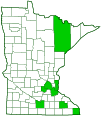northern long-toothed sheetweaver
(Drapetisca alteranda)
Conservation • Description • Habitat • Biology • Distribution • Taxonomy
Conservation Status |
|
|||||||
| IUCN Red List | not listed |
|||||||
| NatureServe | NNR - Unranked |
|||||||
| Minnesota | not listed |
|||||||
Description |
||
Northern long-toothed sheetweaver is a small sheetweb spider. It occurs in North America from Maine south to North Carolina and west to Minnesota, in Colorado, New Mexico, Montana, and Washington, and across southern Canada. It is common in Minnesota but often overlooked due to its small size and cryptic coloration. Adults are found almost exclusively on the bark of a tree, where its color and markings provide excellent camouflage. Spiderlings mature in leaf litter on the ground. Females are ⅛″ to 3⁄16″ (4.0 to 4.5 mm) in length. Males are smaller, ⅛″ (3.2 to 3.8 mm) in length. The front part of the body (cephalothorax) is egg-shaped when viewed from above and flat when viewed from the side. There are eight eyes arranged in two parallel rows of four eyes each. All of the eyes are on black spots. The anterior median eyes (AME) are smaller than the posterior median eyes (PME). The jaw-like mouthparts (chelicerae) have five or six strong teeth on the forward-facing margin and four or five teeth on the rearward facing margin. On the female, the spines on the finger-like sensory mouthparts (palps) are long and conspicuous. The median ocular area (MOA), the area defined by the middle four eyes, is narrower in front than behind. The top of the cephalothorax (carapace) is light with dark brown or black markings, including a Y-shaped mark in the middle, a thin line on the margins, three spots on each side between the middle mark and the margin, and a short stripe behind each posterior lateral eye (PLE). The abdomen is broadly oval, highest in front, and pointed at the rear. It is light with several pairs of gray or black spots. The legs are long, thin, and spiny. They are light with dark rings. There are three minute claws at the end of the last segment (tarsus) but these are not visible without magnification. |
||
Size |
||
Female Body Length: ⅛″ to 3⁄16″ (4.0 to 4.5 mm) Male Body Length: ⅛″ (3.2 to 3.8 mm) |
||
Web |
||
The web is a flat sheet pressed closely against the tree trunk, making it difficult to see. There is no retreat. |
||
Similar Species |
||
Habitat |
||
Woodlands |
||
Biology |
||
Season |
||
July through September |
||
Behavior |
||
Adults are sedentary hunters. Spiderlings disperse in the fall by “ballooning”. They climb a branch, blade of grass, or fencepost, and release a long thread of silk. The silk thread catches the wind or even a light breeze and the spiderling floats to a new site. |
||
Life Cycle |
||
|
||
Food |
||
Small insects and smaller spiders. |
||
Distribution |
||||
|
Sources |
|||
| 5/21/2022 | ||||
Occurrence |
||||
Common |
||||
Taxonomy |
|||
| Class | Arachnida (arachnids) | ||
Order |
Araneae (spiders) | ||
Suborder |
Araneomorphae (typical spiders) | ||
Infraorder |
Entelegynae | ||
Superfamily |
Araneoidea (orbweavers and allies) | ||
| Epifamily | Linyphioidea (dwarf, sheetweb, and hammock-web spiders) | ||
Family |
Linyphiidae (sheetweb and dwarf spiders) | ||
Subfamily |
Linyphiinae (sheetweb spiders) | ||
Genus |
Drapetisca | ||
Some authors place sheetweb spiders in the subfamily Linyphiinae, while others place it in the subfamily Micronetinae. |
|||
Synonyms |
|||
|
|||
Common Names |
|||
northern long-toothed sheetweaver |
|||
Glossary
Carapace
The hard, upper (dorsal), shell-like covering (exoskeleton) of the body or at least the thorax of many arthropods and of turtles and tortoises. On crustaceans, it covers the cephalothorax. On spiders, the top of the cephalothorax made from a series of fused sclerites.
Cephalothorax
The front part of the body of various arthropods, composed of the head region and the thoracic area fused together. Eyes, legs, and antennae are attached to this part.
Chelicerae
The pair of stout mouthparts, corresponding to jaws, in arachnids and other arthropods in the subphylum Chelicerata.
Palp
Short for pedipalp. A segmented, finger-like process of an arthropod; one is attached to each maxilla and two are attached to the labium. They function as sense organs in spiders and insects, and as weapons in scorpions. Plural: palpi or palps.
Tarsus
On insects, the last two to five subdivisions of the leg, attached to the tibia; the foot. On spiders, the last segment of the leg. Plural: tarsi.
Visitor Photos |
|||||
Share your photo of this arachnid. |
|||||
| This button not working for you? Simply email us at info@MinnesotaSeasons.com. Attach one or more photos and, if you like, a caption. |
|||||
Alfredo Colon |
|||||
 |
 |
||||
 |
 |
||||
MinnesotaSeasons.com Photos |
|||||
|
|||||

Slideshows |
||

Visitor Videos |
|||
Share your video of this arachnid. |
|||
| This button not working for you? Simply email us at info@MinnesotaSeasons.com. Attach a video, a YouTube link, or a cloud storage link. |
|||
Other Videos |
|||
| Ecology, Diversity, & Life History 16: Michael Draney American Arachnological Society |
|||
About
Jul 3, 2021 Spatial Distribution of a Tree Trunk Specialist Spider (Linyphiidae: Drapetisca alteranda): Landscape Versus Microhabitat Drivers |
|||

Created: 5/21/2022
Last Updated:



